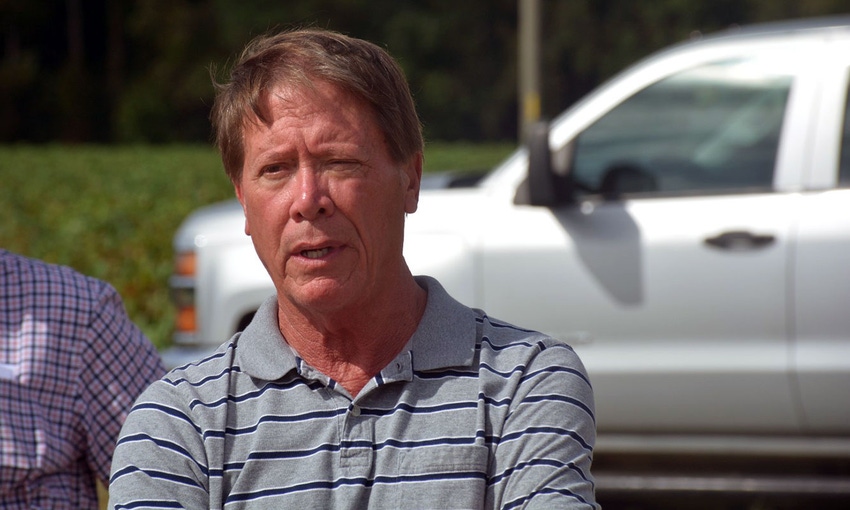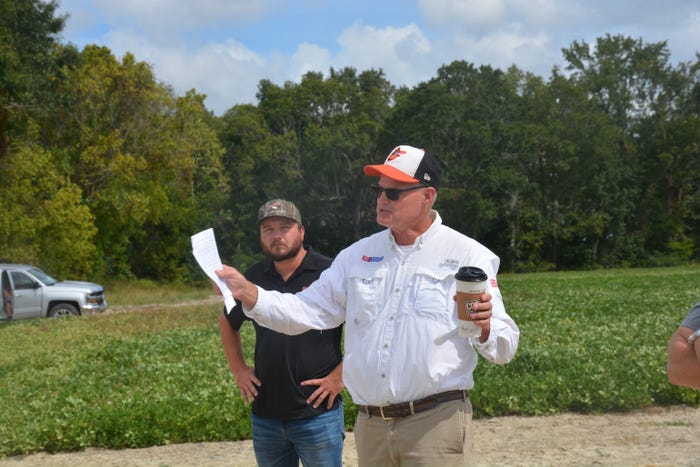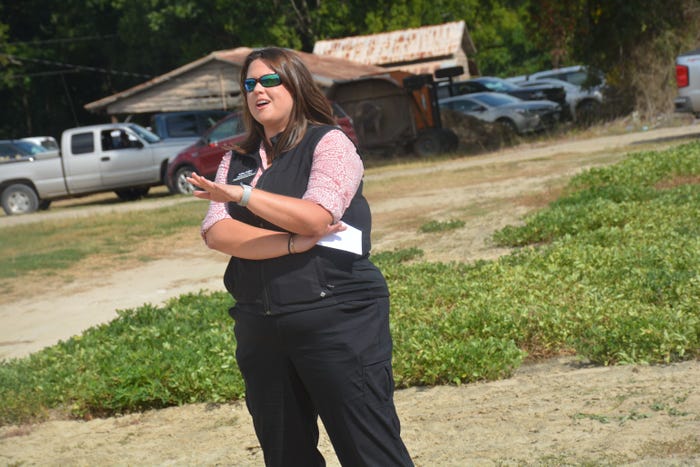
The peanut crop in the Southeast is shaping up to be a good one and if the weather holds it could be an exceptional crop, which the market desperately needs.
That’s the message Dell Cotton, manager of the Peanut Growers Cooperative Marketing Association and executive secretary of the Virginia Peanut Growers Association, brought to the PVQE (Peanut Variety Quality Evaluation) tour at the Taylor Slade Farm in Williamston, N.C. Sept. 21.
Still, Cotton and other tour speakers emphasized it is still early, and we won’t know for sure until the crop is in the barn.
Also at the tour, speakers emphasized that aflatoxin in peanuts is becoming a concern as more peanuts move into the export market, while pesticide issues will also become more pronounced as the export market grows.
Cotton cited the latest USDA report which forecasts eight of the 11 peanut growing states to have average yields of more than 4,000 pounds per acre. Cotton said these figures point to a really good crop nationwide.
“We need a good crop. It is good to know one is coming. Last year, we made 3,800 pounds to the acre on a national basis. This year it’s expected to be 4,100 pounds on a national basis. That 300-pound difference can make a 10% higher crop than we had last year,” Cotton said.
Cotton does not see an over-supply of peanuts this year. “Consumption is up. We need a good supply of peanuts. I think this will be a good crop quality wise to provide that,” he said.
“South Carolina is the only state that reduced acres this year in the VC (Virginia-Carolinas) area. South Carolina has been around 85,000 acres. That’s where they were last year. This year, they were down to 62,0000 to 65,000 acres. South Carolina did decrease, but South Carolina is looking at one of the best crops they have had in a long time. When South Carolina hits 4,000 pounds to the acre, which they are estimated to do on a state average, that’s a good crop for them. They have been down in the 3,500 range up until now. Hopefully, they can get those peanuts in the barn,” Cotton said.
Virginia is looking at a record yield if the weather cooperates through harvest. Cotton said USDA is forecasting an average yield of 4,600 pounds per acre, which would break the record set in 2019 of 4,578 when Virginia farmers harvested an exceptional crop.
“We really need a good Virginia crop. By that I mean a good Virginia-type crop. No one wants a repeat of last year with a prolonged harvest where everything got rained out multiple times. We had an immature crop in 2020 which would not mature, so we had a lack of the larger kernels. In addition, multiple rains darkened the hulls for the inshell market. We made decent yields, but the size and quality were affected,” Cotton said.
“We didn’t have nice bright inshells and we didn’t have the larger kernels our Virginia-type market is known for We need both this year. This crop we have right now I think will be a good answer for that if we can just get it finished,” Cotton said.
Meantime, North Carolina State University Extension Peanut Specialist David Jordan is hoping for a good crop this year, but said he doesn’t share USDA’s optimism for an above average yield in the state.
Dry weather worries
“I think there is a lot of optimism about the crop. But the more I drive around, the more I see dry places. And I know our crop is much spread out in terms of planting dates. We always have 15% planted in June; sometimes that is well into June. With the dry weather, I’m just worried about those peanuts not making what we need to unless we can get some rain and have warm temperatures,” Jordan told PVQE Tour participants.
“I think the crop is going to be a strong average crop. If we have good weather for the remainder of the year, that might make an above average crop,” Jordan said.

North Carolina State University Extension Peanut Specialist David Jordan says that since EPA has banned the use of Lorsban on peanuts in 2022, farmers need to return any supplies they have on hand to their dealers and not use the pesticide at all next year. (John Hart Photo)
He added that as shellers seek to capture more international markets for peanuts, pesticide issues will become more pronounced. Even if a pesticide is labeled in the U.S., the use of certain chemicals may be limited if those peanuts move into the export market.
“Lorsban is now essentially off the market. I know sometimes farmers buy up product when they think it’s going to be lost under the assumption they can use up existing stocks of product. Don’t do that on Lorsban,” Jordan cautioned.
On Aug. 18, EPA announced it would ban chlorpyrifos — or Lorsban — from all food crops. Jordan said it is his impression that from now on, nothing can be sold which has been treated with Lorsban. He urges farmers who have a supply of the material on their farms to return it to their dealers. He stressed that Lorsban cannot be used on the 2022 peanut crop.
“All indications are we will not have that product. We don’t have anything in its place to control rootworms, and I think we need that on about 20% to 25% of our acreage in the region, especially under irrigation,” Jordan said.
And while paraquat can still be used to control weeds and chlorothalonil can be used as a fungicide, Jordan urges peanut farmers to be watchful as the export market for peanuts grows.
Aflatoxin, Export Concerns
“I have some fears coming down the road,” he said. “Those are two products that have been around for a long time and are really important for us. They are a little bit on shaky ground because some of our export markets don’t allow the use of those products in their countries,” Jordan said.
Meanwhile, Ashley Collins, the new CEO of the North Carolina Peanut Growers Association, emphasized that aflatoxin in peanuts continues to be a concern as the U.S. industry seeks to export more of the crop. Collins has been the association’s CEO since June 7, replacing longtime CEO Bub Sutter who retired July 31 after nearly 28 years of service.
Collins said the industry invests a great deal of money testing for the potential of aflatoxin to ensure a safe product for the U.S. and peanuts exported outside the country.
She noted that in the testing standards currently used by the European Union, it only takes half of one kernel testing positive for aflatoxin for the entire 40-foot container to be rejected.
“With Great Britain exiting the EU, efforts are being made to ensure the United Kingdom establishes scientific measures for trade that are more in line with science. We all know we produce a safe crop for Americans. If it’s safe for us, it’s safe across the globe, Collins emphasized.

About the Author(s)
You May Also Like






